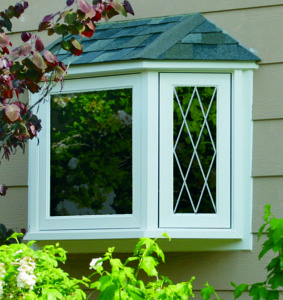Frequently Asked Questions
1. Why are vinyl windows a better choice than windows made from wood or aluminum?
 Your choice of framing material goes a long way toward determining the longevity and energy-efficiency of the total window system. Wood windows possess excellent thermal qualities but are prone to weather deterioration and require maintenance at regular intervals. Aluminum windows are very durable, yet offer little insulating value because they conduct energy rapidly.
Your choice of framing material goes a long way toward determining the longevity and energy-efficiency of the total window system. Wood windows possess excellent thermal qualities but are prone to weather deterioration and require maintenance at regular intervals. Aluminum windows are very durable, yet offer little insulating value because they conduct energy rapidly.
Vinyl windows are your best choice because they offer thermal characteristics similar to wood, are extremely durable and provide a finish that is virtually maintenance-free. Also, keep in mind that the best performing vinyl window systems have multi-chambered frames with welded corners.
2. What is the U-factor?
The U-factor, or U-value, is the measure of a window’s thermal efficiency, based on its resistance to the flow of energy. The lower the U-factor, the more thermally efficient the window. Most new window technology has been aimed at lowering U-factors through the use of three important innovations: warm-edge seals, low emissivity glass coatings and argon/krypton gases.
3. What is a warm-edge seal and why is it important?
Most modern residential window systems are made with dual-pane glass because the air space between the two panes greatly increases the window’s insulation qualities. An edge spacer is used to separate the two panes. Many window manufacturers use a metal edge spacer, but since metal conducts energy, the contact between the glass and spacer significantly lowers the window’s thermal performance around the edge of the glass.
St Clair windows use warm-edge technology instead of a metal spacer. No glass-to-metal contact occurs, thus reducing energy transfer at the edge of the glass and lowering the U-factor. This keeps the window edge warmer during cold weather and also reduces the flow of heat into the home during hot weather. St Clair’s warm-edge sealing system also reduces condensation on the window sash.
4. What is low emissivity glass?
 Low emissivity glass, commonly referred to as Low-E, is glass that has been coated with a micro-thin metallic film to improve thermal performance. The coating reduces the transfer of heat rays through the glass while still allowing light to pass through. In essence, the coating reflects heat back toward its source. Thus, heat from the furnace stays inside the home during cold weather, and heat from the sun stays outside in hot weather, resulting in greater comfort and lower energy costs. Low-E coatings also reduce harmful ultraviolet rays that cause drapes and upholstery to fade.
Low emissivity glass, commonly referred to as Low-E, is glass that has been coated with a micro-thin metallic film to improve thermal performance. The coating reduces the transfer of heat rays through the glass while still allowing light to pass through. In essence, the coating reflects heat back toward its source. Thus, heat from the furnace stays inside the home during cold weather, and heat from the sun stays outside in hot weather, resulting in greater comfort and lower energy costs. Low-E coatings also reduce harmful ultraviolet rays that cause drapes and upholstery to fade.
5. What is argon and krypton gas and why is it used with Low-E glass?
Argon is a safe, odorless, colorless, non-toxic, non-flammable inert gas that is commonly used in place of air between the glass panes of an insulated Low-E glass unit. Argon’s heat conductivity is lower than that of air, and thus it is a better insulator and contributes to a lower U-factor. Argon is not an effective solar performer by itself; that is why it is only used in conjunction with Low-E insulated glass.
Krypton gas is a rare atmospheric gas which is odorless, colorless, tasteless, nontoxic, monatomic and chemically inert. it is also a better insulator than even argon gas. Target Windows & Doors has done extensive testing to combine the two gases to offer our customers the optimum combination with the best value.
6. What is Condensation?
Condensation is visible evidence of excessive moisture in the air. It may appear as water, frost or ice on the interior surface of windows and doors. The warmer the air, the more water the air can hold, which means the air in the center of a room will hold more water than the air adjacent to the window or door walls, since this area is always cooler.
When the warm, moisture laden air moves toward the cooler window or door wall, it becomes cooler and cannot hold the moisture it held when it was warm. The moisture is then dropped and appears as water on the glass and frames of windows and doors. This occurs more frequently during the winter months because of the extreme difference between the indoor and outdoor temperatures. If you wish to avoid condensation during the winter months, when the average outdoor temperature drops below 35° F (2° C), it would be wise to maintain a 25% to 30% relative indoor humidity.
Ventilation is a very effective way to remove excessive moisture from the air, which is why poorly insulated homes with older, air-leaking windows and doors do not often reveal condensation problems. This is because the air and moisture filters out through the gaps in older windows, doors, vents and other openings. Newer homes, which are constructed to meet current insulation standards and energy conservation requirements, or older homes which have been newly insulated through the addition of attic and basement insulation and the installation of insulated window and doors, are now so airtight that they present a new problem.
All homes will, on occasion, have temporary condensation which can result from the following three occurrences:
- New Construction or Remodeling: Building materials contain a great deal of moisture. As soon as the heat is turned on, this moisture will flow out into the air and settle on windows, etc. This will usually disappear following the first heating season.
- Humid Summers: During humid summers, houses absorb moisture. This will be apparent during the first few weeks of the subsequent heating season. Then the house should dry out.
- Temperature change: Sharp, quick and sudden drops in temperature, especially during the heating season, will create immediate formation of moisture but should dissipate in a short period of time.
It is not uncommon for homes which have had new insulated windows and doors installed to suddenly exhibit condensation problems. This is because the new insulated windows and doors don’t leak air like the older ones. The gaps in the original windows and doors were actually allowing air and moisture to escape the home, which reduced the humidity to the point where it wasn’t visible on the interior surfaces. The moisture problem was always present, but the older, air-leaking windows and doors prevented it from being noticed.
If you have an existing moisture or condensation problem, do not count on correcting it merely by installing new windows or doors. You must remember windows and doors do not cause condensation. Therefore, they cannot cure condensation.
Call St Clair of the Ozarks today if you need to replace your windows!

